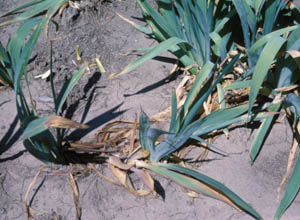Iris Problems | |
|---|---|
| August 2, 2007 | |
|
Not many diseases bother iris plants in Illinois. Leaf spot is a common problem but is not lethal to the plant. Bacterial soft rot and Sclerotium rot can be devastating. A few other diseases occur occasionally, such as rust, some viruses, Fusarium rhizome rot, and Botrytis. The iris leaf spot we usually see is fungal. The Mycosphaerella fungus that infects daylily and gladiolus also infects iris. Lesions caused by this fungus are initially minute, yellow to brown, and are sometimes accompanied by a water-soaked margin. As the lesions grow, they merge, causing leaf tips to die and curl. This leaf spot disease is more common in cool (50° to 77°F), wet weather. Disease has been common this year. For details about the disease and suggestions on management, refer to Report on Plant Disease, no. 629, “Iris Leaf Spot.” This report is available on the Vista Web site: http://www.ag.uiuc.edu/~vista/horticul.htm. Bacterial soft rot has been common in iris beds in 2007. The causal bacterium is Erwinia carotovora. This bacterium is commonly found in soil and plant debris, and it helps speed up plant decomposition. The bacterium needs a wound to enter a plant. Iris soft rot is often associated with the wounds provided by iris borers. For information on the iris borer, refer to issue no. 2, 2003, of this newsletter. Once the bacterium enters the leaves, it causes rotting of the leaf and the attached rhizome, leaving nothing but the outer shell of the rhizome intact. Soft rot bacteria have a distinctively foul smell, something that is difficult to miss. Plants have many brown leaves, as shown in the image of iris plants infected with soft rot.  Clean up your iris beds to get rid of the soft rot bacterium. In Illinois, it is best to do this in late July—now. In fact, most rhizomatous iris plants should be divided every 3 to 5 years to reduce the incidence of soft rot. The idea is to remove unhealthy plant material and thin out the planting to make room for new growth. Dig and lift the iris clumps from the bed and then, using a sharp knife, separate the rhizomes. To avoid spreading the soft rot bacterium, dip the knife in a bleach solution (1 part bleach in 10 parts water) before each new cut. Replant only firm, healthy rhizomes with roots and a fan of leaves. The rhizome should be just slightly exposed on the soil surface when planted correctly. Deep planting also causes rhizomes to rot. Occasionally in Illinois, iris plants are affected by a fungal disease that causes similar symptoms. This disease is Sclerotium crown rot, caused by Sclerotium rolfsii. This fungus is more common in the South, but we see it where mulch has been used around plants over winter. Symptoms appear as they do with bacterial soft rot except rhizomes are brown, soft, and crumbly. A white mycelium of fungal strands is evident in the crown, and tan to reddish brown, mustard-seed-sized fungal structures (sclerotia) can be found on the soil surface or on the plant tissue, as shown in the image.  These structures help the fungus survive adverse conditions and may also be moved with the plant or soil. Beds infected with Sclerotium rolfsii require special help. Remove infected plants from the area. Also remove surrounding soil, putting it directly into a bag to get it out of the area. Be careful to avoid spreading sclerotia to other areas in the garden. Chemical options are available to be used as preventives but will not control this disease on their own. Consult the Home, Yard, and Garden Pest Guide or the 2007 Commercial Landscape & Turfgrass Pest Management Handbook for options. These structures help the fungus survive adverse conditions and may also be moved with the plant or soil. Beds infected with Sclerotium rolfsii require special help. Remove infected plants from the area. Also remove surrounding soil, putting it directly into a bag to get it out of the area. Be careful to avoid spreading sclerotia to other areas in the garden. Chemical options are available to be used as preventives but will not control this disease on their own. Consult the Home, Yard, and Garden Pest Guide or the 2007 Commercial Landscape & Turfgrass Pest Management Handbook for options. |